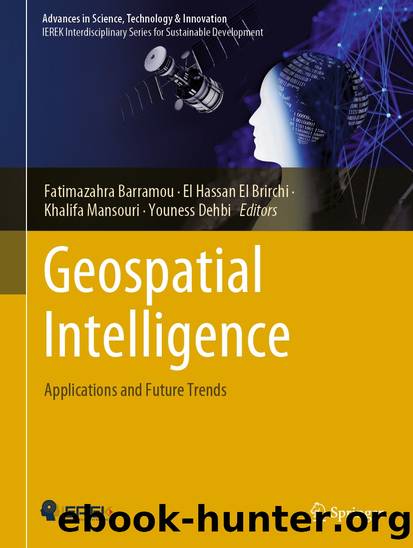Geospatial Intelligence by Unknown

Author:Unknown
Language: eng
Format: epub
ISBN: 9783030804589
Publisher: Springer International Publishing
and lockdown period which runs from 02 March 2020 to 10 June 2020; the period after containment which divided the kingdom into two regions; region 1, where the number of cases had been stable and where the measures were relaxed, and region 2, where the majority of the strict measures were maintained. The second period was characterized by massive testing within industrial environment and the reinforcement of audits for the respect of prevention barriers, including face covering and social distancing as well as increasing the supplies of diagnostic tests, protective equipment, ventilators and essential medicines for quarantined infected and hospitalized patients. This division with the spread of the pandemic in the course of the months has undergone many changes, and currently, the government has changed its strategy and has put the focus on health systems response by accelerating R&D for vaccine trials and production and treatment development, and the optimization of hospital beds and spaces for diagnostics and treatments and the protection of front health workers [14]. We define the third period that experienced the second wave of the pandemic in the country from 01 September to 15 October 2020. The analysis conducted in the previous sections has highlighted a positive correlation of daily incidence within Morocco with Containment and health index and government response that includes approximatively all the measure that we have cited previously and their impacts. Through this part, we explore this correlation in order to detect the main spatiotemporal features of new deaths and new cases time series within Morocco. The main purpose of this analysis is to define the parameters impacting pandemic evolution with regards to spatiotemporal perspective with focus on critical supply chains within the country. Casablanca-Settat region has seen the largest number of cases in the kingdom; being the economic capital of the country, the region has, according to the 2020 forecasts of the Moroccan High Commission for the HCP Plan, more than 7,408,213 inhabitants with 48% in Casablanca and a density of 18,222/km2. Rabat Kenitra Salé region with at its heart the capital Rabat of the kingdom counts 4,867,744 inhabitants followed by Marrakech Safi with 4,774,413 inhabitants, Fez Meknes with 4,405,862 inhabitants and Tangier Tétouane El Hoceima with 3,813,854 inhabitants. Morocco has been undergoing in recent years a genuine demographic transition. Its population is growing, admittedly, but at a slower rate, due to the extension over time of life expectancy in the country, which in 2018 recorded an average of 74 for men and 80 for women, and the decrease in the number of infantâs births that was in 2018 17.5 births/1,000 population. Infant, child and maternal mortality rates have also been reduced, thanks to improved health care, nutrition, hygiene and vaccination coverage. In 2018, the rate reached 4.9 deaths/1,000 population, albeit disparities between urban and rural areas and between rich and poor households have persisted. The decline of Moroccoâs birth rate reflects the decline in the total fertility rate from 5 in the mid-1980s to 2.09 in 2018, due to improvements in womenâs education levels, increased use of contraceptives and delayed marriage.
Download
This site does not store any files on its server. We only index and link to content provided by other sites. Please contact the content providers to delete copyright contents if any and email us, we'll remove relevant links or contents immediately.
| Administration & Medicine Economics | Allied Health Professions |
| Basic Sciences | Dentistry |
| History | Medical Informatics |
| Medicine | Nursing |
| Pharmacology | Psychology |
| Research | Veterinary Medicine |
Machine Learning at Scale with H2O by Gregory Keys | David Whiting(3651)
Fairy Tale by Stephen King(2960)
Will by Will Smith(2586)
Hooked: A Dark, Contemporary Romance (Never After Series) by Emily McIntire(2426)
Rationality by Steven Pinker(2153)
Friends, Lovers, and the Big Terrible Thing by Matthew Perry(2011)
The Becoming by Nora Roberts(1925)
Love on the Brain by Ali Hazelwood(1824)
HBR's 10 Must Reads 2022 by Harvard Business Review(1702)
The Strength In Our Scars by Bianca Sparacino(1700)
A Short History of War by Jeremy Black(1676)
Leviathan Falls (The Expanse Book 9) by James S. A. Corey(1529)
515945210 by Unknown(1524)
Bewilderment by Richard Powers(1453)
443319537 by Unknown(1400)
A Game of Thrones (The Illustrated Edition) by George R. R. Martin(1374)
The Real Anthony Fauci: Bill Gates, Big Pharma, and the Global War on Democracy and Public Health (Childrenâs Health Defense) by Robert F. Kennedy(1337)
The 1619 Project by Unknown(1321)
Fear No Evil by James Patterson(1252)
